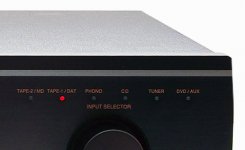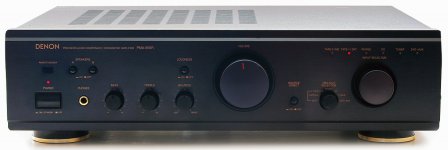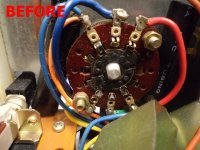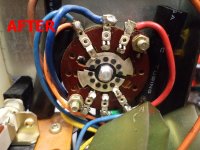Hi folks!
I have a problem with my Denon PMA-655R amplifier. The source input selector starts to "jump" or shift by itself suddenly. It's really annoying when listening to the Tuner and then it goes to the CD or to the Tape 1.
Any Denon user knows or had experienced this before?? How to solve this?
Many thanks in advance!
I have a problem with my Denon PMA-655R amplifier. The source input selector starts to "jump" or shift by itself suddenly. It's really annoying when listening to the Tuner and then it goes to the CD or to the Tape 1.
Any Denon user knows or had experienced this before?? How to solve this?
Many thanks in advance!
Attachments
walk in the park
The selector switch ""drives"" a micro processor or some IC to select the input .
Either the selector switch is dirty/warn but a more common failure for this type of switch is that the grease that existed inside the switch is so dry that the switch loose contact resulting jumping to another source or other type of failure .
You need to clean the grease from inside and apply new but not that much .
Do not try to spray the switch it will have no effect ...sorry to say but there might also be a need to totally disassemble the switch to clean it properly. ( very possible to do )
Kind regards
sakis
The selector switch ""drives"" a micro processor or some IC to select the input .
Either the selector switch is dirty/warn but a more common failure for this type of switch is that the grease that existed inside the switch is so dry that the switch loose contact resulting jumping to another source or other type of failure .
You need to clean the grease from inside and apply new but not that much .
Do not try to spray the switch it will have no effect ...sorry to say but there might also be a need to totally disassemble the switch to clean it properly. ( very possible to do )
Kind regards
sakis
walk in the park
The selector switch ""drives"" a micro processor or some IC to select the input .
Either the selector switch is dirty/warn but a more common failure for this type of switch is that the grease that existed inside the switch is so dry that the switch loose contact resulting jumping to another source or other type of failure .
You need to clean the grease from inside and apply new but not that much .
Do not try to spray the switch it will have no effect ...sorry to say but there might also be a need to totally disassemble the switch to clean it properly. ( very possible to do )
Kind regards
sakis
Many thanks!!
After read your comment I opened the amplifier tonight and, although it was a nightmare to reach the selector switch, I was able to cleaned it. Now the problem seems to be fixed!
I though it could be the relay on the main board and I didn't want to fix it (the relay) cause this amp is quite difficult to work on.
Unfortunately it seems to affect quite few Denon amps. Someone had this same problem with the PMA-2000R. I love Denon amps but I became suspicious now with this weak part of them.
But, anyway: again, many thanks!
You don't need any grease. Just flush that thing with alcohol (IPA/ethanol, doesn't matter) and it'll work as new. This applies to all source selectors of the same type. Common on 90's and 00's gear.
Rubbish ....according to your suggestion you may also clean your oxidized silverware of your grandma with alcohol....
This is what happens inside the switch the silver plated contacts are oxidized and probably look almost black if you open them
You can put the switch inside a canister of alcohol together with the silverware of your grandma for a week and many things might happen except solving the oxidation ....
Farther more there is lubrication inside the switch since it has mech parts Rinse it with alcohol and will never work properly again ....it will become scratchy if not destroyed totally...
this the worst suggestion for this application /failure i heard in all my life ...
been writing this a few times so far i will have to write it once more
First of all in all switches you have 3 problems
1) mechanical : switch have to feel the same after cleaning Lubrication is the key to do that You can not operate a switch especially rotary if dry ...
2) general dirt of any kind for this you can clean with any available fluid you like ...ypu may try anything even coffee without sugar or beer will do
3) oxidized silver plated contacts that go black and loose contact cause of this and very few of existing sprays may clean that but this dont come for free there is side effects
available solutions together with analysis of what they do
you have Philips type of spray red one and blue one the red is petrol ( diesel) has a good cleaning ability , partial ability to actually sweep some of the oxidation not clean it properly and totally , BUT !!! diesel sprays create the step effect especially on pots and then the pot or the switch gives a feeling that works in steps and the operation is not smooth ...Then again diesel may actually burn the plastics exist inside the switch and then you have end of story
farther more diesel left overs actually work as a magnet to dust It is common knowledge from people that used that that is a very temporary fix .....
Another issue is that left overs of this type of sprays have very high conductivity which means that cross-talk of the switch will reach astronomical numbers
the blue spray of Philips
Alike the above but based on gasoline also writing in the can the name degreaser Which obviously means that together with everything else will remove previoucly existing lubrication of your switch and YOU DON'T WANT THAT
cleaning ability of dirt is excellent while there is zero ability to remove or sweep any of the oxidation existing in the contacts ....the danger to destroy plastics is fairly low the switch will feel scratchy after that and the real problem will never be solved . conductivity of the spray is very low self evaporation also so no left overs but also NO JOB DONE
WD40
Will do exactly what diesel sprays do without destroying the plastics with lower cross talk behavior lower conductivity provide quite good lubrication but from most even though better than diesel also don't have the ability to clean oxidation
There is combination of the above from many of the manufacturers which may not be available in Greece so i dont know the behavior Deoxit is very popular here but i am not aware of teh behavior
WD 40 made a new spray contact spray WD40 specialist is called in Greece that has far better ability of cleaning oxidation together with all the other cleaning abilities , fast drying and with excellent conductivity behavior ....Still the ability to clean oxidation is not enough better than others but not enough ...
Bison has a contact spray that has excellent ability to clean everything and especially silver oxidation and its very common to get problems are that conductivity is very very high and left overs are plenty then is in the procedure that will make the difference
1) one may use any of the above sprays based on the target that except cleaning you need to remove oxidation from the contacts
2) use any of the above like degreaser which is based on gasoline and may others that are based on acetone in order to clean the left overs of the previous spray with the danger to damage the plastics inside ( mostly for acetone based )
3) apply tiny bits of classic WD 40 only for lubrication
First of all in all switches you have 3 problems
1) mechanical : switch have to feel the same after cleaning Lubrication is the key to do that You can not operate a switch especially rotary if dry ...
2) general dirt of any kind for this you can clean with any available fluid you like ...ypu may try anything even coffee without sugar or beer will do
3) oxidized silver plated contacts that go black and loose contact cause of this and very few of existing sprays may clean that but this dont come for free there is side effects
available solutions together with analysis of what they do
you have Philips type of spray red one and blue one the red is petrol ( diesel) has a good cleaning ability , partial ability to actually sweep some of the oxidation not clean it properly and totally , BUT !!! diesel sprays create the step effect especially on pots and then the pot or the switch gives a feeling that works in steps and the operation is not smooth ...Then again diesel may actually burn the plastics exist inside the switch and then you have end of story
farther more diesel left overs actually work as a magnet to dust It is common knowledge from people that used that that is a very temporary fix .....
Another issue is that left overs of this type of sprays have very high conductivity which means that cross-talk of the switch will reach astronomical numbers
the blue spray of Philips
Alike the above but based on gasoline also writing in the can the name degreaser Which obviously means that together with everything else will remove previoucly existing lubrication of your switch and YOU DON'T WANT THAT
cleaning ability of dirt is excellent while there is zero ability to remove or sweep any of the oxidation existing in the contacts ....the danger to destroy plastics is fairly low the switch will feel scratchy after that and the real problem will never be solved . conductivity of the spray is very low self evaporation also so no left overs but also NO JOB DONE
WD40
Will do exactly what diesel sprays do without destroying the plastics with lower cross talk behavior lower conductivity provide quite good lubrication but from most even though better than diesel also don't have the ability to clean oxidation
There is combination of the above from many of the manufacturers which may not be available in Greece so i dont know the behavior Deoxit is very popular here but i am not aware of teh behavior
WD 40 made a new spray contact spray WD40 specialist is called in Greece that has far better ability of cleaning oxidation together with all the other cleaning abilities , fast drying and with excellent conductivity behavior ....Still the ability to clean oxidation is not enough better than others but not enough ...
Bison has a contact spray that has excellent ability to clean everything and especially silver oxidation and its very common to get problems are that conductivity is very very high and left overs are plenty then is in the procedure that will make the difference
1) one may use any of the above sprays based on the target that except cleaning you need to remove oxidation from the contacts
2) use any of the above like degreaser which is based on gasoline and may others that are based on acetone in order to clean the left overs of the previous spray with the danger to damage the plastics inside ( mostly for acetone based )
3) apply tiny bits of classic WD 40 only for lubrication
At east electronics we repair an average of above 1000 audio devices per year si we have been there a million times before testing any available chemical existing ...
The solution came 5-6 years ago in the dentist by learning how ultrasonic cleaning for teeth is working so i thought about getting one of this machines trying to modify the frequency to see if i can hit the oxidation with it to clean it
Worked like a charm but we had to create also a chemical product from scratch that doesn't have the side effect of conductivity of the existing sprays , plus the destruction of plastics from diesel sprays ...
You see for us the cleaning of the switch is one issue and the lubrication is another Problem with sprays is that these try to do both in the same can and this actually is not working .
Not to forget that the degreaser spray from Philips is made to flush and rinse the previous spray that they made the diesel one ( at the time )
here is a picture of how an open switch is cleaned before and after ultrasonic .... For sealed switches we use pharmaceutical needles to inject our chemical product inside work the switch inside out and done !! Then you have to rinse flush the ammonia based chemical and relubricate teh switch with a very small bit of WD40
For lubrication it will be enough to spray with WD40 then clean the WD40 thoroughly with pressurized air and relay on the left overs of the WD40 to do the lubrication ...most of the time is enough ....
The solution came 5-6 years ago in the dentist by learning how ultrasonic cleaning for teeth is working so i thought about getting one of this machines trying to modify the frequency to see if i can hit the oxidation with it to clean it
Worked like a charm but we had to create also a chemical product from scratch that doesn't have the side effect of conductivity of the existing sprays , plus the destruction of plastics from diesel sprays ...
You see for us the cleaning of the switch is one issue and the lubrication is another Problem with sprays is that these try to do both in the same can and this actually is not working .
Not to forget that the degreaser spray from Philips is made to flush and rinse the previous spray that they made the diesel one ( at the time )
here is a picture of how an open switch is cleaned before and after ultrasonic .... For sealed switches we use pharmaceutical needles to inject our chemical product inside work the switch inside out and done !! Then you have to rinse flush the ammonia based chemical and relubricate teh switch with a very small bit of WD40
For lubrication it will be enough to spray with WD40 then clean the WD40 thoroughly with pressurized air and relay on the left overs of the WD40 to do the lubrication ...most of the time is enough ....
Attachments
Last edited:
try to spray any open switch that you might have in your shop to realize the cleaning ability of your spray ...
If you are in the service business operating 1000 audio devices per year one thing that you dont want is a customer that pay a complete rebuild of a vintage amplifier to come back after 4-5 months while still on guarantee with scratchy or squeeky pots
We never looked for a temporary solution or a quick fix we actually wanted something that will last for more than 10-20 years ( this is how much time it took for the switch to become that black )
Both ultrasonic , ammonia based cleaning solution ( with a few more things inside obviously ) and lubrication actually did the trick ...
Kind regards
Sakis
If you are in the service business operating 1000 audio devices per year one thing that you dont want is a customer that pay a complete rebuild of a vintage amplifier to come back after 4-5 months while still on guarantee with scratchy or squeeky pots
We never looked for a temporary solution or a quick fix we actually wanted something that will last for more than 10-20 years ( this is how much time it took for the switch to become that black )
Both ultrasonic , ammonia based cleaning solution ( with a few more things inside obviously ) and lubrication actually did the trick ...
Kind regards
Sakis
we had a Sansui AU 717 to repair
Problem was excessive 50hz noise at AUX input ok at phono ok at tapes
It took quite a while to isolate the problem and when amplifier was switched to AUX input there was almost 33 volts DC involved in the all auxiliary line one ch more other less
We isolated the problem on the selector switch thinking that probably the switch inside was ham and cheese toast and messing up AUX signal with the voltage controlling the indicator led
( in AU 717 the switch is actually doing that IE selecting inputs while a part of teh switch provides selection voltage for indicator leds )
The switch come out of it dirty oxidized but other than those absolutely functional no toast inside ( i was expecting a piece of metal loose inside making the mess )
Took while to find but the problem was that the PCB part of the switch that actualy has the pins of the switch encapsulated had become conductive because it has been "drinking " a good amount of a wrong spray
We actually had to dremel out e few mm of PCB between the pins to solve the problem
If one has the ability to see the switch will notice that the bottom part is made by pcb material ....which actually looks like a toast with the inner parts ready to drink anything while the top and bottom is polished in order not to do that
Encapsulated pins on the "pcb" have also some glue or other material on the base of them to provide additional isolation but seems that one pin actually failed
This is what a bad spray choice might do
I will see if i can find pics of the specific problem to post
Kind regards
Sakis
Problem was excessive 50hz noise at AUX input ok at phono ok at tapes
It took quite a while to isolate the problem and when amplifier was switched to AUX input there was almost 33 volts DC involved in the all auxiliary line one ch more other less
We isolated the problem on the selector switch thinking that probably the switch inside was ham and cheese toast and messing up AUX signal with the voltage controlling the indicator led
( in AU 717 the switch is actually doing that IE selecting inputs while a part of teh switch provides selection voltage for indicator leds )
The switch come out of it dirty oxidized but other than those absolutely functional no toast inside ( i was expecting a piece of metal loose inside making the mess )
Took while to find but the problem was that the PCB part of the switch that actualy has the pins of the switch encapsulated had become conductive because it has been "drinking " a good amount of a wrong spray
We actually had to dremel out e few mm of PCB between the pins to solve the problem
If one has the ability to see the switch will notice that the bottom part is made by pcb material ....which actually looks like a toast with the inner parts ready to drink anything while the top and bottom is polished in order not to do that
Encapsulated pins on the "pcb" have also some glue or other material on the base of them to provide additional isolation but seems that one pin actually failed
This is what a bad spray choice might do
I will see if i can find pics of the specific problem to post
Kind regards
Sakis
@east electronics thank you for your posts, They are very informative but after all I still dont know what should I use in diy home way. I know more what I should not and then not much left.
Can you suggest which contact cleaner should I use?
@picowallspeaker "I always use that" You mean Philips?
Can you suggest which contact cleaner should I use?
@picowallspeaker "I always use that" You mean Philips?
- Status
- This old topic is closed. If you want to reopen this topic, contact a moderator using the "Report Post" button.
- Home
- Amplifiers
- Solid State
- HELP!! Denon PMA-655R (source selector)



